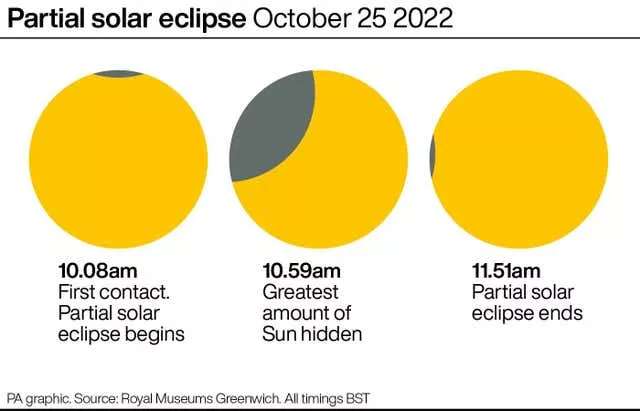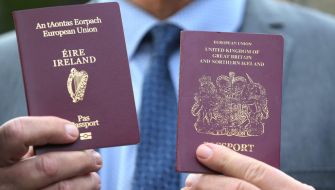About 25 per cent of the Sun will be blocked out on Tuesday as the Moon passes between it and the Earth.
Skygazers across the Ireland will be able to see the phenomenon, with Dr Robert Massey, of the Royal Astronomical Society in the UK, stating the eclipse will cause the Moon to block the view of “some or all of the bright solar surface”, and the Sun will “appear to have a bite taken out of it”.
A partial solar eclipse is taking place tomorrow, and it will be visible across the UK! The Moon will pass right in front of the Sun, blotting out up to around 25% of its disc. 🌞🌚
📷: Robin Scagell/Galaxy pic.twitter.com/2J5DL0UFm0— Royal Astronomical Society (@RoyalAstroSoc) October 24, 2022
The eclipse will be visible across Ireland and the UK, as well as large parts of Europe and Asia.
For skygazers in Ireland, the eclipse is expected to last from approximately 10am to 11.45am, reaching its peak between 10.50am and 11am.
Jake Foster, astronomer at Royal Observatory Greenwich, said: “The amount of obscuration you’ll see will depend on where you are on the Earth.”
He added: “Even though a portion of the Sun’s light will be blocked, it will not get noticeably darker during the eclipse.”

Dr Massey said looking directly at the Sun can cause serious damage to the eyes, even when a large fraction of the solar disc is blocked out.
It is also not wise not to look at the Sun through binoculars, telescopes or a telephoto lens on an SLR camera.
He added: “The simplest way to watch an eclipse is to use a pinhole in a piece of card.
“An image of the Sun can then be projected on to another piece of card behind it (experiment with the distance between the two, but it will need to be at least 30 cm).
“Under no circumstances should you look through the pinhole.”
🌞Don't forget to tune in tomorrow morning for our solar eclipse livestream!
🤞Fingers crossed for good weatherhttps://t.co/G8XDhUD2F9— Royal Museums Greenwich (@RMGreenwich) October 24, 2022
Dr Massey said another popular method used to view an eclipse is the mirror projection method.
He said: “You need a small, flat mirror and a means of placing it in the sun so that it reflects the sunlight into a room where you can view it on a wall or some sort of a flat screen.
“You may also have eclipse glasses with a certified safety mark, and these are available from specialist astronomy suppliers.
“Provided these are not damaged in any way, you can then view the Sun through them.”
Binoculars or telescopes can also be used to project the image of the Sun.
Dr Massey said: “Mount them on a tripod, and fit one piece of card with a hole in it over the eyepiece, and place another between 50 cm and a metre behind it.
“Point the telescope or binoculars towards the Sun and you should see its bright image on the separate card.”
For those keen to follow the event, the Royal Observatory Greenwich will live-stream the eclipse on its website and YouTube channel.







